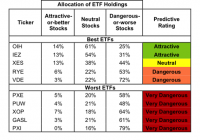Best And Worst Q1’16: Energy ETFs, Mutual Funds And Key Holdings
The Energy sector ranks ninth out of the ten sectors as detailed in our Q1’16 Sector Ratings for ETFs and Mutual Funds report. Last quarter , the Energy sector ranked last. It gets our Dangerous rating, which is based on aggregation of ratings of 23 ETFs and 112 mutual funds in the Energy sector. See a recap of our Q4’15 Sector Ratings here . Figures 1 and 2 show the five best and worst-rated ETFs and mutual funds in the sector. Not all Energy sector ETFs and mutual funds are created the same. The number of holdings varies widely (from 25 to 153). This variation creates drastically different investment implications and, therefore, ratings. Investors seeking exposure to the Energy sector should buy one of the Attractive-or-better rated ETFs or mutual funds from Figures 1 and 2. Figure 1: ETFs with the Best & Worst Ratings – Top 5 Click to enlarge * Best ETFs exclude ETFs with TNAs less than $100 million for inadequate liquidity. Sources: New Constructs, LLC and company filings The Van Eck Market Vectors Uranium+Nuclear Energy ETF (NYSEARCA: NLR ), the PowerShares Dynamic Oil & Gas Services Portfolio (NYSEARCA: PXJ ), and the Van Eck Market Vectors Unconventional Oil & Gas ETF (NYSEARCA: FRAK ) are excluded from Figure 1 because their total net assets are below $100 million and do not meet our liquidity minimums. Figure 2: Mutual Funds with the Best & Worst Ratings – Top 5 Click to enlarge * Best mutual funds exclude funds with TNAs less than $100 million for inadequate liquidity. Sources: New Constructs, LLC and company filings The Van Eck Market Vectors Oil Services ETF (NYSEARCA: OIH ) is the top-rated Energy ETF and the Fidelity Select Energy Service Portfolio (MUTF: FSESX ) is the top-rated Energy mutual fund. OIH earns an Attractive rating and FSESX earns a Neutral rating. The First Trust ISE Water Index Fund (NYSEARCA: FIW ) is the worst-rated Energy ETF and the Saratoga Advantage Energy and Basic Materials Portfolio (MUTF: SBMBX ) is the worst-rated Energy mutual fund. FIW earns a Dangerous rating and SBMBX earns a Very Dangerous rating. 184 stocks of the 3000+ we cover are classified as Energy stocks. The FMC Technologies (NYSE: FTI ) is one of our favorite stocks held by OIH and earns an Attractive rating. While the Energy market has certainly had its issues over the past two years, FMC Technologies business has continued to exhibit strength. Over the past five years, FMC has grown after-tax profit ( NOPAT ) by 9% compounded annually. The company currently earns a return on invested capital ( ROIC ) of 12%. Best of all, FMC has earned positive economic earnings every year since 2006. Despite the above, FTI declined over 37% in 2015. Now, at its current price of $25/share, FTI has a price to economic book value ( PEBV ) ratio of 0.8. This ratio means that the market expects FMC’s NOPAT to permanently decline by 20% over its remaining corporate life. If FMC can grow NOPAT by just 2% compounded annually for the next decade , the stock is worth $31/share today – a 24% upside. The Diamondback Energy (NASDAQ: FANG ) is one of our least favorite stocks held by SBMBX and earns a Dangerous rating. Despite reporting impressive revenue growth, Diamondback Energy’s business is in decline. The company’s economic earnings have declined from -$32 million in 2012 to -$331 million over the trailing twelve months. Diamondback’s ROIC has fallen from 3% to -2% over the same timeframe. Despite the deterioration of the business, FANG was up 12% in 2015, which has left shares highly overvalued. To justify its current price of $58/share, Diamondback must grow NOPAT by 12% compounded annually for the next 18 years . When contrasted with Diamondback’s short history of value destruction, this expectation appears overly optimistic. Figures 3 and 4 show the rating landscape of all Energy ETFs and mutual funds. Figure 3: Separating the Best ETFs From the Worst ETFs Click to enlarge Sources: New Constructs, LLC and company filings Figure 4: Separating the Best Mutual Funds From the Worst Mutual Funds Click to enlarge Sources: New Constructs, LLC and company filings D isclosure: David Trainer and Kyle Guske II receive no compensation to write about any specific stock, sector or theme.
